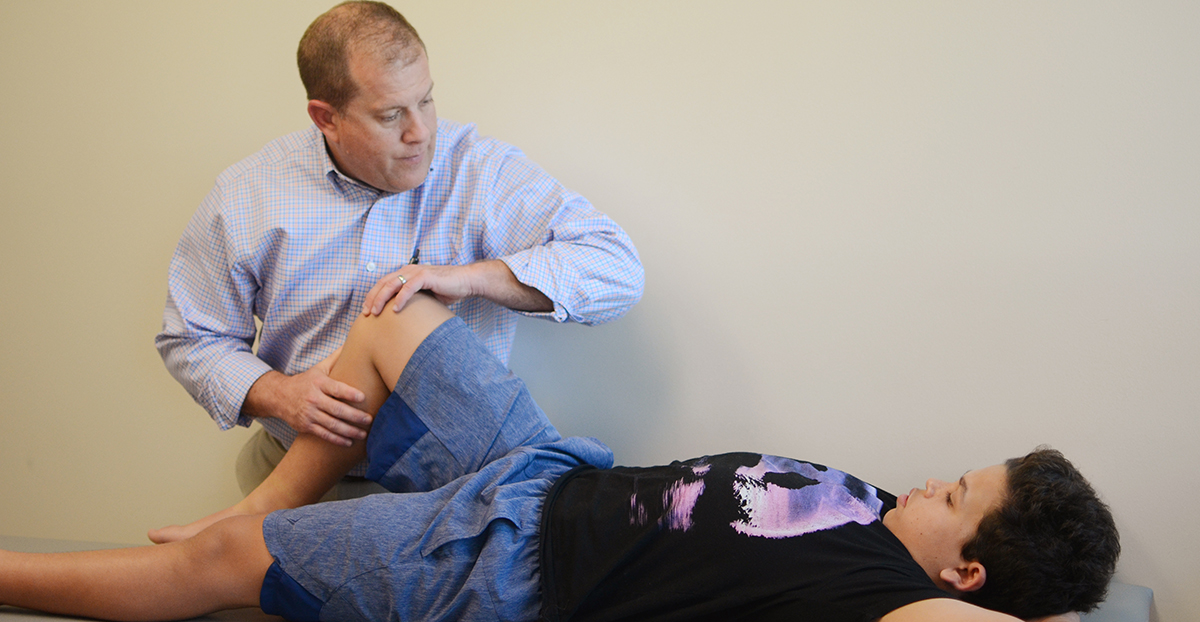
Oct 19, 2017 / Research & Innovation
Knee Injuries in Growing Athletes are Not Always What They Seem
Most knee injuries in growing adolescents involve soft tissues in the joint such as the meniscus or ligaments. However, in rare cases, a bone injury may occur inside the joint with or without soft tissue injuries.
In conjunction with our colleagues in pediatric sports medicine, staff orthopedist Henry B. Ellis, M.D. and nurse practitioner Chuck W. Wyatt, C.P.N.P., R.N.F.A. co-authored a recently published study of cases including adolescent patients referred to our sports medicine center with one of these rare bone injuries. The study focused on patients with a fracture in the fastest growing growth plate of the body called the distal femoral physis. These patients had all experienced a knee injury and fifty percent of them were injured while playing football.
Of all cases reviewed, identification of the fracture was delayed 39% of the time and some (10%) were not referred for further care for more than a week. This is likely because the fracture is commonly very small and difficult to see in a standard X-ray. In the initial evaluation of a knee injury with swelling, this diagnosis, though rare, needs to be considered. Therefore, after ruling out a soft tissue injury or a larger fracture of the leg, an MRI and a referral to a pediatric orthopedic specialist are recommended. Delayed or missed diagnosis can result in long term complications that may require additional surgery.
Wyatt expresses concern about these fractures being missed and the possibility of this injury changing the growth of the affected leg if not identified properly. “Without an accurate diagnosis and treatment, this injury can lead to complications and a longer path to recovery,” says Wyatt. “Much of our work in pediatric orthopedics is focused on recognizing injuries that may cause disturbances in normal growth. We do so by being prompt and monitoring the growth after the injury.”
At Scottish Rite Hospital, studies like these help us to establish standards for evaluating and identifying diagnoses with a high risk of causing potentially preventable growth-related complications. We continue to conduct research and enhance our knowledge of these adolescent injuries to ultimately provide the best care to our patients.
Learn more about our research in pediatric sports medicine.
In conjunction with our colleagues in pediatric sports medicine, staff orthopedist Henry B. Ellis, M.D. and nurse practitioner Chuck W. Wyatt, C.P.N.P., R.N.F.A. co-authored a recently published study of cases including adolescent patients referred to our sports medicine center with one of these rare bone injuries. The study focused on patients with a fracture in the fastest growing growth plate of the body called the distal femoral physis. These patients had all experienced a knee injury and fifty percent of them were injured while playing football.
Of all cases reviewed, identification of the fracture was delayed 39% of the time and some (10%) were not referred for further care for more than a week. This is likely because the fracture is commonly very small and difficult to see in a standard X-ray. In the initial evaluation of a knee injury with swelling, this diagnosis, though rare, needs to be considered. Therefore, after ruling out a soft tissue injury or a larger fracture of the leg, an MRI and a referral to a pediatric orthopedic specialist are recommended. Delayed or missed diagnosis can result in long term complications that may require additional surgery.
Wyatt expresses concern about these fractures being missed and the possibility of this injury changing the growth of the affected leg if not identified properly. “Without an accurate diagnosis and treatment, this injury can lead to complications and a longer path to recovery,” says Wyatt. “Much of our work in pediatric orthopedics is focused on recognizing injuries that may cause disturbances in normal growth. We do so by being prompt and monitoring the growth after the injury.”
At Scottish Rite Hospital, studies like these help us to establish standards for evaluating and identifying diagnoses with a high risk of causing potentially preventable growth-related complications. We continue to conduct research and enhance our knowledge of these adolescent injuries to ultimately provide the best care to our patients.
Learn more about our research in pediatric sports medicine.



